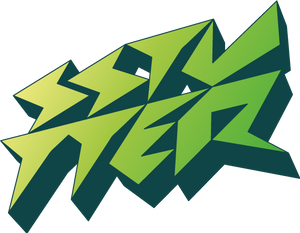Setting the scene is a very important part of telling the story of a brand, and since SSTUTTER is so new, there is much to be told. My current challenge is to introduce myself to everyone and make sure they know who they are dealing with.
This Christmas, I have been accepted to display and sell the products at a couple of craft and fashion fairs (details of which are at the end of this post). Both events specialise in independent makers and designers from the local area of East London. This is not an opportunity to be missed, so I decided to go all out and design my very own point of sales and give the stall a truly unique look. I wanted to give the spectator and customer something new. Along with custom branded plinths, signage and a mirror, the centre piece is a custom display bust which is undeniable SSTUTTER.
This blog post will take you through the process of designing the bust and the challenges and issues faced along the build.
Firstly, I'd like to thanks Base Models, who kindly gave me the space and use of the workshop in order to build most of the display products. The extensive tools and machines at their disposal have added the professional touch to the display items. Without their help, I would not have been able to build these items. Check out the website in the link here.
I went on eBay and found a bust which I felt had the right form. This was going to be the basis of the sculpture. I had already decided that I wanted to make the bust in a geometric styling similar to the aesthetic of the jewellery and I also decided that I wanted to use the bust for product photographs as well as a display at events.
...

After the bust arrived, I began by drawing lines on the dummy with permanent markers. This was like a sketch stage, to help me visual and manifest my aim. At this point, it was my intention to transform the whole dummy — front and back.
...


Next I began to use styrene sheet plastic to mock up the shape I was looking for. Styrene is a very cheap and versatile plastic which is easy to cut with a scalpel and is excellent at receiving paint. Early into the build, I realised that I would have difficulty sticking anything to the original eBay bust. The original bust seemed to be made from vinyl, or a rubber, and glue wasn't adhering to it - I knew paint would not either. I had to cover the bust in masking tape and then stick the shapes to the masking tape. My plan was to remove the joined shape afterward - like a shell.
...


To personalise the bust, I added the SSTUTTER logo on top of the neck. This was made from layered laser cut acrylic.
...

As the shape and the triangles covered the surface of the bust, I decided that I wanted to only do the front and have a cut away. I felt that not only was this less work, but I would have a more delicate product which would contrast the aggression of the angles. This also meant that I had to cut as much of the existing dummy away and encapsulate it since nothing will stick to it. The original bust had to be completely surrounded by something else in order for me to add paint to it.
...


I decided to use expanding foam to fill the inside of the dummy and to also encapsulate the existing bust. Expanding foam is an excellent product, however care is needed to prevent it touching anything you don't want foam on. It is near impossible to remove.
...


Expanding foam is very easy to sculpt. I filled the bust with as much as I could in order for it to completely fill the inside. I knew I could trim it back afterwards to achieve the shape I required.
...


After the foam was sculpted, I added a column so that the dummy could stand. It was also at this stage that I began to fill deep voids with Polyfiller and car body filler and give it the first coat of paint. The back where the foam was exposed was also covered in a layer of car body filler. The painting and filling process would be repeated until all surface imperfections are covered and made good.
...

The name of the game now is to get as good a finish as possible. I decided to get the worst voids out with filler and then when that was done, fill the rest of them with a two part filler spray. The spray is normally used in automotive and product model making and is very good at levelling areas. The aim was to fill the cracks and not worry to much about runs as the paint can be sanded when it had set (which was about 16 hours).
As you can see this has rounded many of the edges. I was not to upset about this as I was free with how the build progressed and I simply had an idea I was creating rather than a fixed brief. My initial research and influence for the sculpture came from anime such as 'Neon Genesis Evangelion' and top 80's film 'Robocop'. I also looked at car design and other types of product, like Dyson vacuum cleaners. I wanted to create something which was simultaneously female and androgynous. I also wanted to create something which was both organic and manufactured.
...


After much spraying and sanding, the bust was eventually given its final colour coat. This left the sculpture with a matt finish. At this point the bust is virtually done, however the paint is easy to mark and damage. To ensure the bust is more durable, I decided to give it a few layers of lacquer. The lacquer will also serve to give some surface depth and create an illusion that the final product is cast and more classical.


So here it is, the final product. An acrylic base had been added in order to increase the footprint and make the bust more stable. A lot had changed from how I first thought about it, however I am pleased with the end result. Hopefully the bust will really show off the jewellery and be a real feature piece for the stall.



